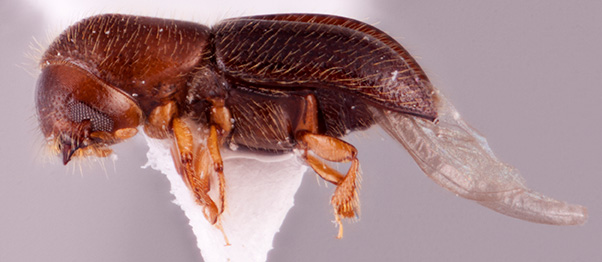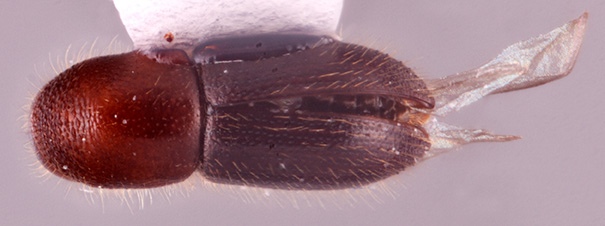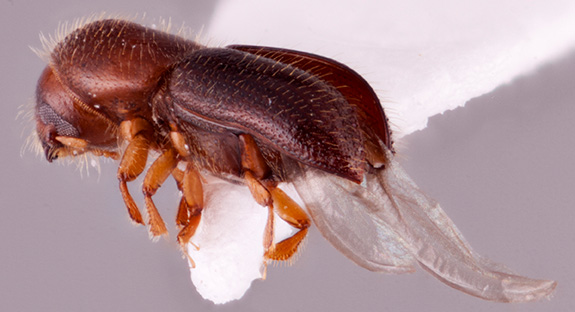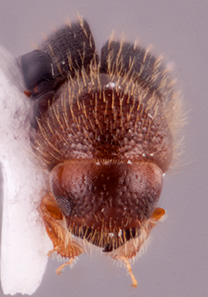Fraudatrix
|
Fraudatrix melas; R.K. Osborn |
|
Fraudatrix melas; R.K. Osborn |
|
Fraudatrix melas; R.K. Osborn |
|
Fraudatrix melas; R.K. Osborn |
Taxonomy
Fraudatrix Cognato, Smith and Beaver, 2020 (in Cognato et al. 2020a): 544.
Diagnosis
Length 1.75–2.5 mm and 2.86–3.33 times as long as wide. Fraudatrix can be distinguished by the following combination of characters: antennalantennal:
pertaining to the antennae
funicle 2-segmented, antennalantennal:
pertaining to the antennae
club type 2 with one suture visible on the posteriorposterior:
toward the rear end; opposite of anterior
 face, protibiaprotibia:
face, protibiaprotibia:
tibia of the first pair of legs
obliquely triangular with 6 or fewer denticlesdenticle:
a small tooth, the sides of which are equal and the tip is above the middle of the base on outer margin and posteriorposterior:
on outer margin and posteriorposterior:
toward the rear end; opposite of anterior
 face flattened and unarmed, scutellumscutellum:
face flattened and unarmed, scutellumscutellum:
a shield-like sclerotized plate located at the midpoint of the elytral base
small, flush with elytralelytral:
pertaining to the elytra
surface, mycangial tufts absent, elytraelytron:
the two sclerotized forewings of beetles that protect and cover the flight wings
attenuateattenuate:
gradually tapering apically
 and pronotalpronotal:
and pronotalpronotal:
pertaining to the pronotum
discdisc:
the flat central upper surface of any body part (e.g. pronotum and elytra) longer than anterioranterior:
longer than anterioranterior:
the front or forward; opposite of posterior slope (Cognato et al. 2020aCognato et al. 2020a:
slope (Cognato et al. 2020aCognato et al. 2020a:
Cognato AI, Smith SM, Beaver RA. 2020a. Two new genera of Oriental xyleborine ambrosia beetles (Coleoptera, Curculionidae: Scolytinae). Zootaxa 4722: 540-554. https://doi.org/10.11646/zootaxa.4722.6.2).
Fraudatrix most closely resembles Cryptoxyleborus and Tricosa with which it shares an attenuateattenuate:
gradually tapering apically
 appearance and small size. It can be distinguished from Cryptoxyleborus by the following diagnostic characters (Fraudatrix given first): scutellumscutellum:
appearance and small size. It can be distinguished from Cryptoxyleborus by the following diagnostic characters (Fraudatrix given first): scutellumscutellum:
a shield-like sclerotized plate located at the midpoint of the elytral base
visible vs scutellumscutellum:
a shield-like sclerotized plate located at the midpoint of the elytral base
not apparent, antennalantennal:
pertaining to the antennae
club truncatetruncate:
appearing cut off or suddenly shortened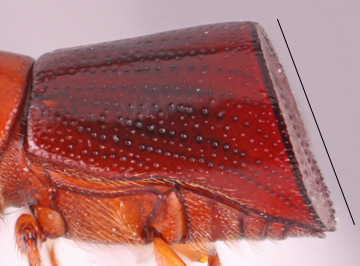 and type 2 vs flattened and type 4, antennalantennal:
and type 2 vs flattened and type 4, antennalantennal:
pertaining to the antennae
funicle 2-segmented vs 3-or 4-segmented, no more than one suture visible on the posteriorposterior:
toward the rear end; opposite of anterior
 face vs three sutures visible. Fraudatrix is also similar to Stictodex with which it shares a type 2 antennalantennal:
face vs three sutures visible. Fraudatrix is also similar to Stictodex with which it shares a type 2 antennalantennal:
pertaining to the antennae
club, two-segmented funiclefunicle:
part of the antenna that is proximal to the club; composed of 2-4 segments in xyleborines.
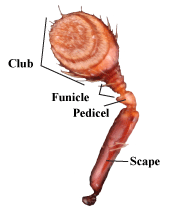 and obliquely triangular protibiaprotibia:
and obliquely triangular protibiaprotibia:
tibia of the first pair of legs
. Stictodex is easily distinguished from Fraudatrix by the following combination of characters: larger size and stouter form (2.4–3.3 mm long; 2.54–2.89 times as long as wide), antennalantennal:
pertaining to the antennae
club very broad, protibiaeprotibia:
tibia of the first pair of legs
with 6–8 denticlesdenticle:
a small tooth, the sides of which are equal and the tip is above the middle of the base on outer margin and posteriorposterior:
on outer margin and posteriorposterior:
toward the rear end; opposite of anterior
 face inflatedinflated:
face inflatedinflated:
blown up; distended
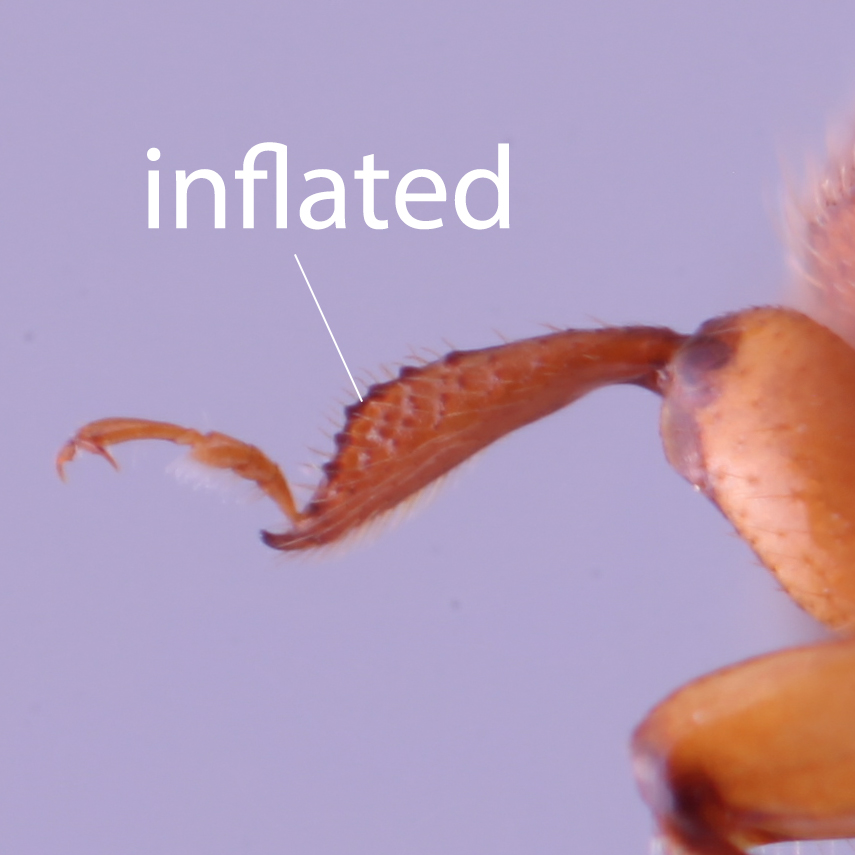 and granulategranulate:
and granulategranulate:
pertaining to a coarse, grainy surface texture
 , elytraelytron:
, elytraelytron:
the two sclerotized forewings of beetles that protect and cover the flight wings
with first and second interstriaeinterstria:
longitudinal spaces along the elytra between the striae, which is not as<br />
impressed and bear smaller punctures.
 divergent, broadest at elytralelytral:
divergent, broadest at elytralelytral:
pertaining to the elytra
summit, and declivitydeclivity:
downward slope of either the pronotum or elytra
 truncate or broadly rounded (Cognato et al. 2020aCognato et al. 2020a:
truncate or broadly rounded (Cognato et al. 2020aCognato et al. 2020a:
Cognato AI, Smith SM, Beaver RA. 2020a. Two new genera of Oriental xyleborine ambrosia beetles (Coleoptera, Curculionidae: Scolytinae). Zootaxa 4722: 540-554. https://doi.org/10.11646/zootaxa.4722.6.2).
May be confused with
Cryptoxyleborus, Cyclorhipidion, Stictodex, and Tricosa
Distribution
throughout the Oriental and Australian regions
Gallery system
Only the gallery of F. cuneiformis has been described. The system has branched tunnels with small brood chambers in the longitudinal plane (Browne 1961).
Remarks
Specimens of this genus are very rarely collected.

